
The Gnaphalieae are a tribe of flowering plants in the family Asteraceae. It is most closely related to the tribes Anthemideae, Astereae, and Calenduleae.
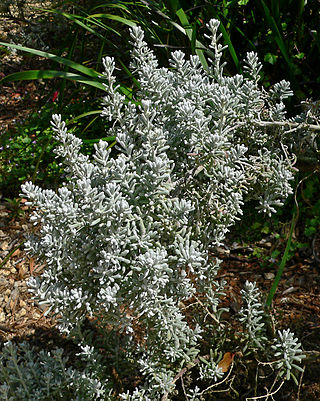
Maireana is a genus of around 57 species of perennial shrubs and herbs in the family Amaranthaceae which are endemic to Australia. Species in this genus were formerly classified within the genus Kochia. The genus was described in 1840 by the botanist, Moquin-Tandon and named to honour Joseph François Maire (1780-1867), an amateur botanist who befriended him during the author's first visit to Paris in 1834.

Petrophile is a genus of evergreen shrubs, in the family Proteaceae. The genus is endemic to Australia. Commonly known as conebushes, they typically have prickly, divided foliage and produce prominently-displayed pink, yellow or cream flowers followed by grey, conical fruits.
Chthonocephalus is a genus of annual herbs in the family Asteraceae. The genus is endemic to Australia, with species occurring in all mainland states.

Conostylis is a genus of perennial herbs in the Haemodoraceae family, commonly known as cone flowers. All species are endemic to the south west of Western Australia.
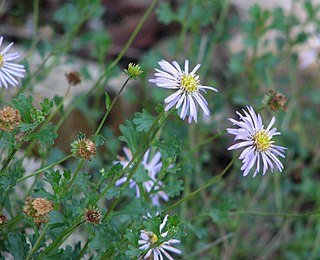
Calotis is a genus of herbs or small shrubs in the daisy family Asteraceae. Most of the species are native to Australia, while two occur in Asia.
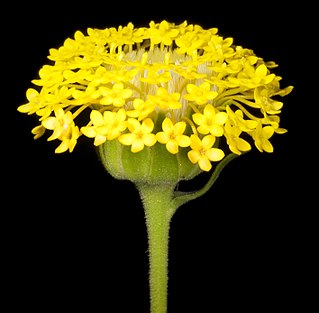
Podotheca is a genus of flowering plants in the tribe Gnaphalieae within the family Asteraceae. All species are endemic to Western Australia, except for Podotheca angustifolia which occurs across the south of Australia.
Minuria is a genus of annuals, perennials and dwarf shrubs in the tribe Astereae within the familyAsteraceae.
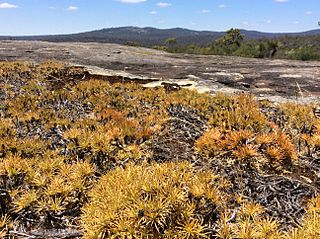
Borya is a genus of flowering plants in the family Boryaceae, endemic to Australia.
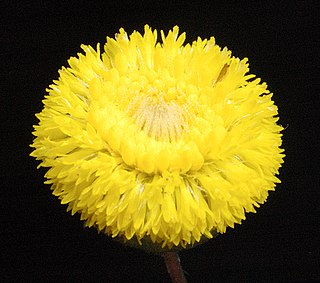
Panaetia, a genus in the Asteraceae (daisy) family, was first described by Henri Cassini in 1829 It is considered by Plants of the World Online and the Global Compositae Database to be a synonym of Podolepis Labil,. while GBIF states it as "doubtful". However, in 2021, the Western Australian Herbarium accepted Jeffery Jeanes new circumscription of the genus, together with two species of Panaetia as being found in Western Australia: Panaetia lessonii, and Panaetia tepperi. Jeanes distinguished Panaetia from the genera, Podolepis, Siemssenia and Walshia, using the following characters:
- the outer florets are all tubular; and
- the cypselas are minutely tuberculate and lack long finger-like papillae.

Asteridea pulverulenta is a species of flowering plant in the Asteraceae family, which is endemic to Western Australia, in the south-west. It was first described in 1839 by John Lindley.

Asteridea chaetopoda is a species of herb in the Asteraceae family, which is endemic to Western Australia, in the south-west. It was first described in 1876 as Athrixia chaetopoda by Ferdinand von Mueller, and allocated to the genus, Asteridea, in 1980 by G. Kroner. It is a perennial herb, growing on sandy soils, on limestone and on gypsum, to heights from 5 cm to 30 cm. Its yellow flowers may seen from August to November on salt lakes, stony rises, and dunes of Beard's Eremaean and South-West Provinces.
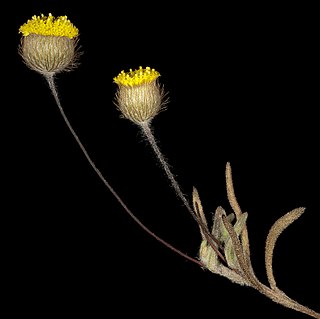
Asteridea athrixioides is a herb in the Asteraceae family, which is endemic to Australia, and found in Western Australia, South Australia and Victoria. It was first described in 1853 by Otto Sonder and Ferdinand von Mueller as Panaetia athrixioides, who described it from specimen(s) collected in the Port Lincoln district. In 1980, G. Kroner assigned it to the genus, Asteridea, giving it the name Asteridea athrixioides. It is an annual herb, growing on calcareous, sandy or clay soils to heights of from 5 cm to 20 cm. Its yellow flowers may seen from July to November on saline on allvial flats, rocky hills and undulating plains.
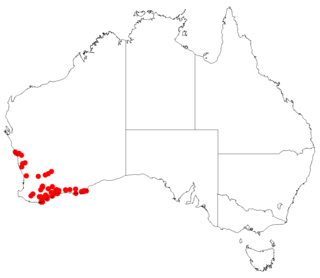
Asteridea asteroides is a herb in the Asteraceae family, which is endemic to Western Australia. It was first described in 1853 by Nikolai Turczaninow as Trichostegia asteroides. In 1980, G. Kroner assigned it to the genus, Asteridea, giving it the name Asteridea asteroides. It is a perennial herb, growing on sand or gravelly sand to heights of from 5 cm to 30 cm. Its white flowers may seen from August to November in Beard's South-West Province.
Asteridea archeri is a herb in the family Asteraceae, which is endemic to Western Australia. It was first described in 2000 by Philip Short. It is found growing on gypsum dunes in salt lakes to heights from 20 cm to 1 m. Its white flowers may seen from September to October in Beard's Eremaean Province. There are no synonyms.

Asteridea morawana is a herb in the Asteraceae family, which is endemic to Western Australia. It was first described in 2000 by Philip Short.
Asteridea croniniana is a herb in the Asteraceae family, which is endemic to Western Australia. It is an annual herb, growing to a height of 8 cm.

Pembertonia latisquamea is a species of daisy (Asteraceae), native to Western Australia. It was first described by Ferdinand von Mueller in 1878 as Brachyscome latisquamea and transferred to the genus, Pembertonia in 2004 by Philip Short.

Pentalepis is a genus of flowering plants in the family Asteraceae which is endemic to Australia and found only in the Northern Territory and Western Australia.

Hybanthus floribundus is a plant in the Violaceae family, found in southern Western Australia, southern South Australia, Victoria and southern New South Wales.
















